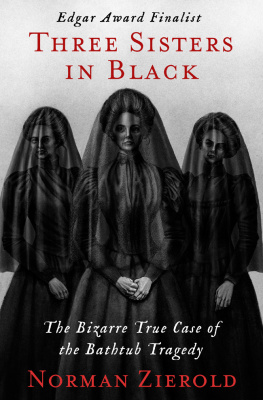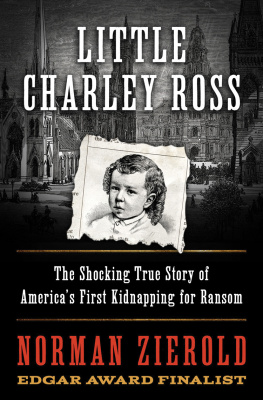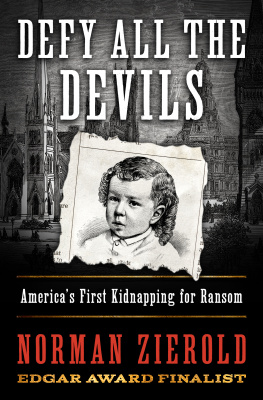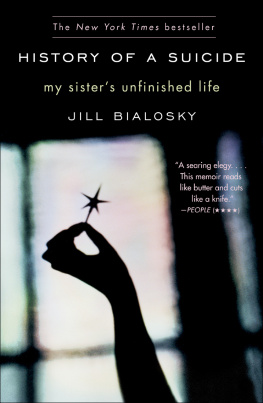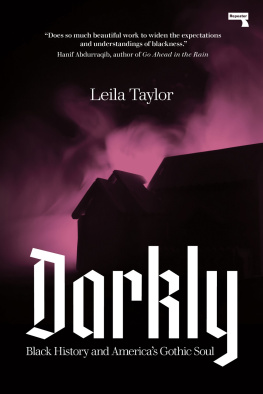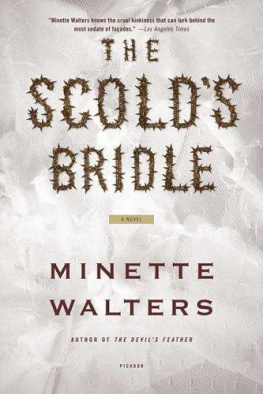



Three Sisters in Black
The Bizarre True Case of the Bathtub Tragedy
Norman Zierold
For Edith Bel Geddes and Bert Marino friends dear to my heart
1
To stargazers on the Eastern seaboard, November 27, 1909, was memorable for a total eclipse of the moon, which shrouded the night in densest black. For inhabitants of East Orange, New Jersey, then a quiet residential suburb of New York, the darkness later seemed a sinister omen, an angry augury. The next day, Sunday, remained cool and gray. On Monday afternoon, November 29, a telephone call pierced the small-town stillness, opening one of the most macabre crime mysteries in modern times.
At 388 Main Street, East Orange police headquarters, Sergeant Timothy Caniff picked up the receiver. He noted the time as 4:40 P.M. At the other end of the line a womans voice, soft and cultivated, asked whether a coroner could be sent immediately to her house. There had been an accident. The sergeant explained that the county had no coroners office; he would send out a physician. The soft voice gave an address, 89 North Fourteenth Street, and hung up. Unable to reach the county physician, Caniff called his assistant, Herbert M. Simmons. Dr. Simmons walked to the designated location from his nearby office, crossing the Lackawanna Railroad overpass, then continuing three short blocks on North Fourteenth Street before reaching number 89, a cheerless gray frame house of two stories topped by an attic.
Medical satchel in hand, he was climbing the porch steps when the front door opened. Before him stood a tall spare woman dressed all in black, a long cape flowing to the ground, heavy veils secreting the face. Startled by this somber apparition, the physician was relieved to hear the pleasing accents of the South in the voice that beckoned to him.
Please come in, it said. I am Virginia Wardlaw.
Simmons identified himself. Silently, the woman in black led him up a flight of stairs and down the second-floor hallway. Open doors along the way gave no sign of occupancy. At the end of the hall, the woman halted. Simmons hesitated, knowing he was about to see what he had come for, the intractable face of death.
For the physician it was an everyday experience, and yet one to which he was never fully reconciled. Steeling himself, he turned the knob, pushed the door, saw that he had entered the bathroom. There it was, the nude body of a young woman in the small, half-filled bathtub. The slender figure was in a crouching position, legs doubled up at the knees, the left hand lightly grasping a washcloth, the head submerged in the cold bath water and tipped slightly to the right, directly under the faucet. Long auburn hair streamed like a fan on the water. The physician gently raised the head and saw a face that must in life have been very beautifuleach feature fine and classically formed, dominated by large brown eyes now fixed in a sightless stare.
After a preliminary inspection of the body, Simmonss attention shifted to a pile of clothing on the floor. To one of the garments a note was pinned. The physician read the bold clear handwriting:
Last year my little daughter died; other near and dear ones have gone before. I have been prostrated with illness for a long time. When you read this I will have committed suicide. Do not grieve over me. Rejoice with me that death brings a blessed relief from pain and suffering greater than I can bear.
O. W. M. S NEAD
Who is this woman? Simmons asked the veiled figure in the doorway.
She is my niece, Ocey Snead. She has been despondent since her first child died last year. Then her husband died seven months ago. She also has a four-month-old son who is ill in St. Christophers Hospital in Brooklyn. She herself has been in very poor health.
When did you find the body?
Only a short time before I called the police station.
At this reply, the physician looked up sharply. He tried to control his voice so that accusation would not enter: But this woman has been dead fully twenty-four hours.
Well, perhaps she has, answered Virginia Wardlaw. The truth of the matter is, she asked me yesterday afternoon to start a fire in the kitchen range to heat water for her bath. She was about to take a nap. I started a fire and then, having business to attend to, went away, leaving her to sleep undisturbed.
Were you two living alone in this house?
Yes.
And in twenty-four hours you never made inquiry, never went to see how she was when she didnt appear at meals or before bedtime?
She had asked not to be disturbed, did I not tell you?
The rooms in this house seem empty. Why are you living like this? Why havent you any furniture, or any comforts?
It has suited us to live this way. We had only settled here temporarily.
Despite his efforts to appear casual, Simmonss tone had become increasingly challenging; that of his interlocutor had grown cold, almost disdainful. Virginia Wardlaw refused to reply at all to further questioning and asked the physician to complete his business as swiftly as possible. On leaving, Simmons noted again the empty rooms, the lack of heat in the cold, bleak house. At the nearest telephone he called the police station, reporting the case as an apparent suicide but with suspicious elements that warranted sending a detective.
An hour had passed since the original call to the Main Street station. It was nearing six oclock and night had fallen when Sergeant William H. ONeill knocked at number 89. The curtains were drawn. It appeared that a dim gas lamp burned within. When the door opened the woman in black stood framed in the entranceway, demanding to know the sergeants business. He had been ordered to inspect the premises, he explained. In caustic tones, she said she did not understand why, then turned and led the way upstairs. In the bathroom, ONeill saw the body and read the suicide note. He asked to see the rest of the house.
The tour started with the attic. It was completely empty. Returning to the second floor, ONeill thrust his head first into one room, then into a second, and a third. Each was empty, with only a silk maternity gown in a closet bearing mute witness to the life that had ebbed away. A fourth small room opened over the porch. In it stood the narrow cot which had been the dead girls last bed. By the pillow ONeill found a locket containing the photo of a smiling baby. Two pins held a tag which read: Lock of David Sneads first hair Aug. 18, 09. On the floor lay a pair of dainty shoes and a fine black silk gown, evidence of onetime affluence: also a broad-cloth coat with silver lining and white silk facings on the lapels. Near the cot was a barrel covered with a white cloth. Combs and hairpins indicated it had been used as a makeshift dressing table. On a box in the corner stood a package of cereal and empty cans that had contained evaporated milk. Bits of oranges and orange peelings were scattered around the room. The only element of decoration to relieve the pathetic squalor was a painting of a ballerina on one wall.
Next page
